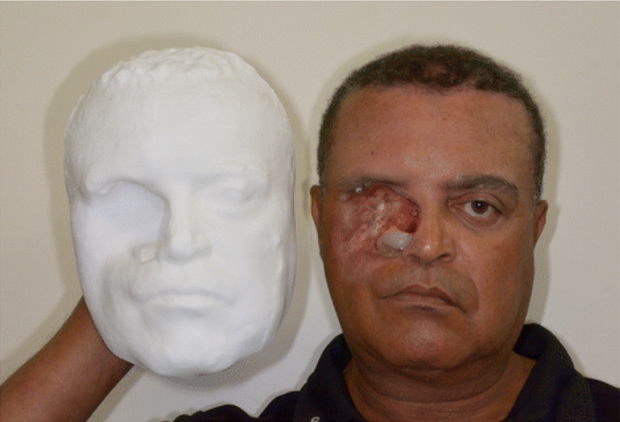A man made a facial prosthesis using a smartphone and a 3D printer

Additive technologies allowed a 54-year-old man from Brazil to get a high-quality and aesthetic face prosthesis. It was made by a team of American and Brazilian doctors using a smartphone, a special free 3D modeling application, and a 3D printer.
Facial defects can be the result of various cases: tumors, transmission of infectious diseases, congenital anomalies, serious injuries, surgical interventions, etc. If they are not very large, then they are trying to correct them with the help of plastic surgery. However, in some cases, plastic surgeons are powerless. A partial or complete face transplant from a dead donor is still a very expensive operation and is performed in isolated cases. Therefore, patients have no choice but to order their own facial prosthesis. For the high-quality manufacturing of such an object, qualified specialists are needed, of which there are very few at the moment and a sufficiently long period of time.
It took a man from Brazil, Carlito Conseisan, to apply for a facial prosthesis. Eight years ago, he was removed a malignant tumor that formed on the hard palate. As a result of a complex operation, a man lost an eye and a part of his nose. The prosthesis made at that time was very fragile, corresponded poorly to the individual parameters of the patient, caused considerable discomfort and looked completely unaesthetic.
')

Having suffered with such a prosthesis, at the beginning of this year, a man turned to the clinic of the University of Paulista, located in São Paulo. Since the doctors did not have suitable expensive equipment to create a prosthesis, they decided to make it from the available and available tools.
To start, the doctors took 15 pictures of the patient's face from different angles using an Android-based smartphone. Then these photos were uploaded to the free Autodesk 123D Catch application, which formed a single 3D model of the face. The resulting 3D model was processed on a computer and a high-quality silicone prosthesis was printed on a 3D printer. Next, the object was transferred to the artist, who gave him the most natural look. And after that, the prosthesis was securely attached by magnets to the screws that the doctors had previously screwed into the facial bones of the man.

The created 3D-printed prosthesis has a beautiful aesthetic appearance, can be easily removed and cleaned, if desired, but during everyday activities - washing in the shower, training in the gym, etc. - it does not disappear, since the magnets securely hold it.
The lifetime of the silicone prosthesis is up to three years. However, since the cost of such a product is quite low and can be made in a very short time, then ordering another sample is not difficult. In particular, the prosthesis was created by researchers of the Renat Arsher Center and the University of Illinois in just 20 hours.
When Carlito Conseisanu saw his renewed face in the mirror, he was so impressed that he began to cry - so the work of the medical staff was of high quality and professional.

It is likely that the new method of creating facial prostheses will be an alternative to the expensive and long-term production of prostheses using traditional methods. By the way, Gorbatov Roman, the head of the laboratory of additive technologies at the Federal State Budgetary Educational Institution “PFMITS” of the Ministry of Health of Russia, will very soon tell you about the achievements of 3D printing in prosthetics and medicine in the Russian Federation.
Source: https://habr.com/ru/post/372851/
All Articles